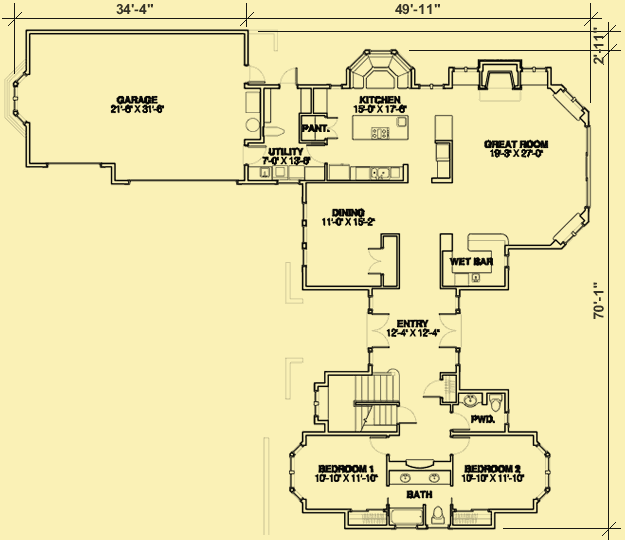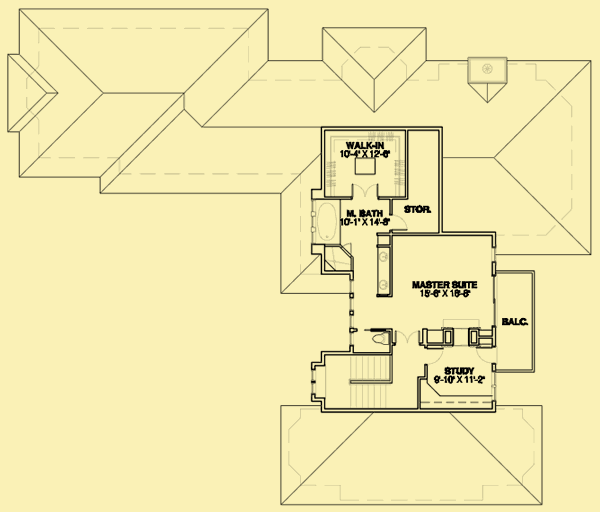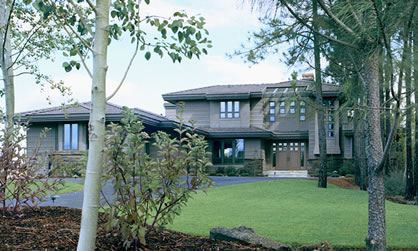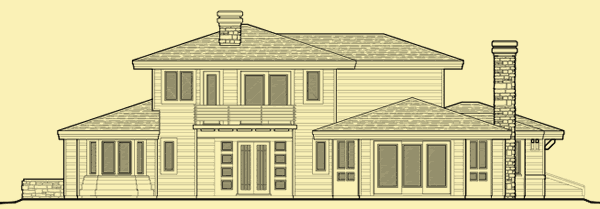Main Level Floor Plans For Unobstructed Views

Upper Level Floor Plans For Unobstructed Views


| Total Above-ground living area | 3046 |
| Main Level | 2226 |
| Upper Level | 820 |
| Lower level living area | |
| Footprint The dimensions shown are for the house only (indicating the smallest area needed to build). They do not include the garage, porches, or decks, unless they are an integral part of the design. |
70.083 W x 49.917 D |
| Above-ground bedrooms | 3 |
| Above-ground bathrooms | 2.5 |
| Master suite | Upper |
| Lower-level bedrooms | 0 |
| Lower-level bathrooms | 0 |
| Stories | 2 |
| Parking | garage |
| Number of stalls | 3 |
| House height
Traditionally, the overall height of a house is determined by measuring from the top of the finished floor on the main level, to the highest peak of the roof.
|
25.75 |
| Ceiling heights Raising or lowering the height of the ceilings on one or more floors of a house is often a simple change that can be made by your builder. However, if you want to raise the ceiling of the main floor of a two-story home, there has to be room to add steps to the existing staircase. |
|
| Main level | 9.5 |
| Upper level | 9.5 |
| Vaulted ceilings
We consider a room to be vaulted if the ceiling - whether flat, angled, or curved - is above 10 feet at its highest point. If you prefer that one or more rooms not be vaulted in your new home, this is a very simple change that your builder can make for you.
KEY TO SYMBOLS: LR = Living Room/Great Room DR = Dining Room FAM = Family Room FOY = Foyer STU = Study/Library/Den KIT = Kitchen SUN = Sunroom MBR = Master Bedroom MB = Master Bath LOF = Loft OFF = Office/Guest Room REC = Recreation/Game Room ALL = Entire Level |
LR, BR2, BR3 |


Recessed double doors surrounded by glass open to a stunning foyer area. The 9’6″ ceiling is criss–crossed by decorative wood beams that match the other wood detailing throughout the interior. The entry separates the main level into two wings on either side, while another pair of doors straight ahead opens to the rear patio space.
On the right side of the entryway there’s a coat closet and a powder room off of a vestibule that also provides access to two stairways – one leading up to the master suite and another down to a wine cellar beneath the house – and two bedrooms. Each bedroom features large bay windows facing either the front or rear, and they share a bathroom with two separate sinks. The ceilings in these rooms slope from 9’6″ to 13′.
The left side of the main level is where the living spaces are located. A short hall opens to a formal dining room on your left, a great room on your right, and a kitchen straight ahead. Three large windows in the dining room provide natural light and views. There’s a decorative storage closet in this room, and a dropped soffit runs around the outer edge of the ceiling.
As you can see from the photo, the great room is filled with light and views to the rear. Angled corner windows above built–in seats add a unique visual element, and there’s a large fireplace flanked by built–in cabinets on one wall. A full wet bar is conveniently located in one corner. The ceiling in this room rises to 12’6″, and it is accented by decorative beams that meet in the middle.
The gourmet kitchen features a large center island with a range on top, a walk–in pantry, and a charming nook framed in glass that bumps out to the side of the house. A door in the kitchen opens to a laundry/utility room which then opens to a 3–car garage.
The “couple’s realm” occupies the entire upper level of the house. The stairway is lit by 5 pairs of small windows stacked one above the other. Like all the non–vaulted rooms on the main level, the ceilings are set at a lofty 9’6″. The bedroom features an optional two–sided fireplace between it and the study next to it, and large sliding glass doors that open to a private balcony. The study has doors opening to both the stair landing and the balcony, and two large windows provide light and views. As you enter the bath area, there is a grouping of 10 more small windows straight ahead, with a private toilet to your left. To the right there are two separated sinks, a large soaking tub beneath three large windows over three small windows, a shower, and a huge walk–in closet. There’s also a storage space off of the dressing area.




This stunningly attractive home was originally designed for a pair of avid golfers who wanted a spacious upstairs master suite, and unobstructed views of the golf course. A unique “texture” was created on the exterior by using alternating 4″ and 8″ horizontal cedar siding, which pairs beautifully with the stone veneer and tile roof. Small rectangular windows add to this home's appeal both inside and out.
We highly recommend that you click on two boxes – the number of bedrooms you know you need, and one less bedroom. For example, if you need 4 bedrooms, click on the boxes next to 4 and next to 3. Otherwise you will not see homes where existing rooms on the lower, main, or upper levels might work perfectly well as a bedroom instead of as an office, study, etc.
